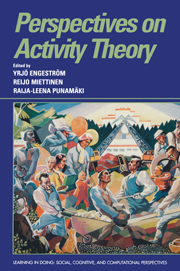Book contents
- Frontmatter
- Contents
- List of contributors
- Series foreword
- Introduction
- Part I Theoretical issues
- Part II Language and its acquisition
- Part III Play, learning, and instruction
- Part IV Technology and work
- 21 The theory of activity changed by information technology
- 22 Activity theory, transformation of work, and information systems design
- 23 Innovative learning in work teams: Analyzing cycles of knowledge creation in practice
- Part V Therapy and addiction
- Author index
- Subject index
21 - The theory of activity changed by information technology
Published online by Cambridge University Press: 05 June 2012
- Frontmatter
- Contents
- List of contributors
- Series foreword
- Introduction
- Part I Theoretical issues
- Part II Language and its acquisition
- Part III Play, learning, and instruction
- Part IV Technology and work
- 21 The theory of activity changed by information technology
- 22 Activity theory, transformation of work, and information systems design
- 23 Innovative learning in work teams: Analyzing cycles of knowledge creation in practice
- Part V Therapy and addiction
- Author index
- Subject index
Summary
Introduction
Progress in informatics and information technology has greatly influenced theoretical psychology. On the other hand, psychological knowledge is increasingly used to support the processes of applying and developing information technology.
In this chapter, I discuss these mutually dependent tendencies from the viewpoint of the psychological theory of activity. I focus on problems and prospects of creativity and creative activity in conditions of rapid development and pervasive implementation of information technology in various spheres of human activity.
The delegation of certain human functions to computers presents the theory of activity with new problems. What is the nature of the activity performed by humans in the context of advanced computerization?
How does human activity change when humans use computers? Computer science constantly uses the notions of routine and creative. Focusing on creativity reveals a large gap between psychological studies of activity and psychological studies of creativity. Theories of activity and theories of creativity have developed as separate domains of inquiry.
We witness both the tendency of negation of the theory of activity by the theory of creativity and the tendency of negation of the theory of creativity by the theory of activity. It has been claimed that among the most important trends in the development of the psychology of creativity in Russia are the “gradual substitution of the principle of activity by the principle of interaction and … substitution of the activity concept by the systems concept” (Lomov & Anzyferova, 1989, p. 28).
Information
- Type
- Chapter
- Information
- Perspectives on Activity Theory , pp. 347 - 359Publisher: Cambridge University PressPrint publication year: 1999
Accessibility standard: Unknown
Why this information is here
This section outlines the accessibility features of this content - including support for screen readers, full keyboard navigation and high-contrast display options. This may not be relevant for you.Accessibility Information
- 12
- Cited by
